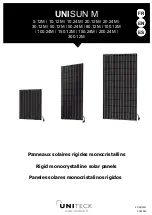
10-SSI-001_rev.005_ENG
Page
23
of
51
HelioSphera modules have been designed and tested, according to IEC 61646 paragraph
10.16, to a maximum mechanical loading of 2400 Pa (2, 4 N/m
2
or 240 Kg/m
2
).This loading can
be any combination of snow, ice or wind. In order for the solar modules to withstand this loading
the module must be supported as shown in Fig. 14 and Fig. 17
In any roof installation check carefully with local authorities/local building codes for
minimum mechanical means for securing the module.
5.2 Location and Tilt Angle
HS Atlas, HS Venus, and HS Glass-Glass modules should ideally be installed in a
location where they will receive maximum sunlight throughout the year.
The modules should typically face South (for installations in the Northern Hemisphere. In
the Southern Hemisphere modules should be facing North) and be tilted at an angle
approximately equal to the
location’s latitude for optimum performance. Ideal inclination for each
area should be calculated using a PV system simulation software. Installations facing East
and/or West or variable tilt angles are also possible, although the energy yield may be less than
optimum.
When choosing a site, avoid trees, buildings or obstructions, which could cast shadows on
the solar photovoltaic modules especially during the winter months when the arc of the sun is
lower over the horizon. Shading causes loss of output, even though the factory fitted a by-pass
diode on the module to minimize these kinds of losses.
The modules connected in series should be installed at same orientation and angle. Also
strings connected in parallel should all consist of modules installed at same orientation and
angle. For more info see
next point “6.- Electrical installation”. Different orientation or angle may
cause loss of output power due to differences in the amount of sunlight irradiance level.
The modules produce the optimum power when they are pointed directly towards the sun.
For grid connected installations where the modules are attached to a permanent structure, the
modules should be tilted so that the energy production from the PV modules will be maximized
on an annual basis. The module tilt angle defined as the angle between the module surface and
the complete horizontal plane. A minimum angle of 10
°
is recommended in order to help the
self-cleaning of the modules.
Nevertheless, one of the merits of Heliosphera modules is that they have minimal losses
in non-optimum tilt angles and orientation or in diffuse light conditions.
Summary of Contents for HS Atlas Series
Page 1: ...10 SSI 001_rev 005_ENG Page 1 of 51 SAFETY AND INSTALLATION INSTRUCTIONS...
Page 38: ...10 SSI 001_rev 005_ENG Page 38 of 51 Fig 27 Laser marking 2D barcode Fig 28 Module label...
Page 43: ...10 SSI 001_rev 005_ENG Page 43 of 51 12 CERTIFICATES 12 1 Modules...
Page 44: ...10 SSI 001_rev 005_ENG Page 44 of 51...
Page 45: ...10 SSI 001_rev 005_ENG Page 45 of 51...
Page 46: ...10 SSI 001_rev 005_ENG Page 46 of 51...
Page 47: ...10 SSI 001_rev 005_ENG Page 47 of 51 12 2 Junction boxes...
Page 48: ...10 SSI 001_rev 005_ENG Page 48 of 51 12 3 Cables...
Page 49: ...10 SSI 001_rev 005_ENG Page 49 of 51 12 4 Connectors...
Page 50: ...10 SSI 001_rev 005_ENG Page 50 of 51 12 5 Factory Inspection...
Page 51: ...10 SSI 001_rev 005_ENG Page 51 of 51 12 6 Quality Management System...
















































